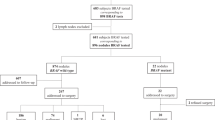Abstract
BRAF V600E mutations are common in papillary thyroid carcinoma (PTC) and some de-differentiated thyroid cancers. In this study, we summarize AUS/FLUS diagnosed cases from thyroid fine needle aspirations in our center from 2015 to 2017 to explore the impact of BRAF V600E detection on the cytopathological diagnosis of PTC. BRAF V600E detection could significantly reduce the AUS/FLUS diagnosis rates from 11.59 to 8.42% when all BRAF V600E-mutated AUS/FLUS cases were diagnosed as conforming to PTC (20.01 to 19.13% in 2016 and 10.92 to 7.93% in 2017, respectively). The AUS/M rates decreased from 0.67 to 0.64 in 2016 and from 0.33 to 0.23 in 2017. We further discuss a case with a single BRAF V600E cytological mutant lacking a postoperative PTC diagnosis and discuss the limitations of BRAF V600E detection using puncture elution fluid. Our findings support the notion that BRAF V600E detection can effectively reduce the diagnostic rates of AUS/FLUS and help clinicians decide both treatment strategies and patient prognosis.


Similar content being viewed by others
References
Gharib H, Goellner JR, J Annals of Internal Medicine (1993) Fine-needle aspiration biopsy of the thyroid: an appraisal. 118 (4):282, 289
Ali SZ, Cibas ES (2010) The Bethesda System for Reporting Thyroid Cytopathology.
Xing M (2007) BRAF mutation in papillary thyroid cancer: pathogenic role, molecular bases, and clinical implications. Endocr Rev 28 (7):742–762. doi:https://doi.org/10.1210/er.2007-0007
Ali SZ, Cibas ES (2018) The Bethesda System for Reporting Thyroid Cytopathology. 3. doi:https://doi.org/10.1007/978-3-319-60570-8.
Xing MJERC (2005) BRAF mutation in thyroid Cancer 12 (2):245–262
Nikiforov YE, Seethala RR, Tallini G, Baloch ZW, Basolo F, Thompson LD, Barletta JA, Wenig BM, Al Ghuzlan A, Kakudo K, Giordano TJ, Alves VA, Khanafshar E, Asa SL, El-Naggar AK, Gooding WE, Hodak SP, Lloyd RV, Maytal G, Mete O, Nikiforova MN, Nose V, Papotti M, Poller DN, Sadow PM, Tischler AS, Tuttle RM, Wall KB, LiVolsi VA, Randolph GW, Ghossein RA (2016) Nomenclature Revision for Encapsulated Follicular Variant of Papillary Thyroid Carcinoma: A Paradigm Shift to Reduce Overtreatment of Indolent Tumors. JAMA Oncol 2 (8):1023–1029. doi:https://doi.org/10.1001/jamaoncol.2016.0386
Kim TH, Park YJ, Lim JA, Ahn HY, Lee EK, Lee YJ, Kim KW, Hahn SK, Youn YK, Kim KH, Cho BY, Park DJ (2012) The association of the BRAF(V600E) mutation with prognostic factors and poor clinical outcome in papillary thyroid cancer: a meta-analysis. Cancer 118 (7):1764–1773. doi:https://doi.org/10.1002/cncr.26500
Xing M, Westra WH, Tufano RP, Cohen Y, Rosenbaum E, Rhoden KJ, Carson KA, Vasko V, Larin A, Tallini G, Tolaney S, Holt EH, Hui P, Umbricht CB, Basaria S, Ewertz M, Tufaro AP, Califano JA, Ringel MD, Zeiger MA, Sidransky D, Ladenson PW (2005) BRAF mutation predicts a poorer clinical prognosis for papillary thyroid cancer. J Clin Endocrinol Metab 90 (12):6373–6379. doi:https://doi.org/10.1210/jc.2005-0987
Xing M, Haugen BR, Schlumberger M (2013) Progress in molecular-based management of differentiated thyroid cancer. Lancet 381 (9871):1058–1069. doi:https://doi.org/10.1016/S0140-6736(13)60109-9
Liu X, Yan K, Lin X, Zhao L, An W, Wang C, Liu X (2014) The association between BRAF (V600E) mutation and pathological features in PTC. Eur Arch Otorhinolaryngol 271 (11):3041–3052. doi:https://doi.org/10.1007/s00405-013-2872-7
Xing M, Alzahrani AS, Carson KA, Viola D, Elisei R, Bendlova B, Yip L, Mian C, Vianello F, Tuttle RM, Robenshtok E, Fagin JA, Puxeddu E, Fugazzola L, Czarniecka A, Jarzab B, O'Neill CJ, Sywak MS, Lam AK, Riesco-Eizaguirre G, Santisteban P, Nakayama H, Tufano RP, Pai SI, Zeiger MA, Westra WH, Clark DP, Clifton-Bligh R, Sidransky D, Ladenson PW, Sykorova V (2013) Association between BRAF V600E mutation and mortality in patients with papillary thyroid cancer. JAMA 309 (14):1493–1501. doi:https://doi.org/10.1001/jama.2013.3190
Lim JY, Hong SW, Lee YS, Kim BW, Park CS, Chang HS, Cho JY (2013) Clinicopathologic implications of the BRAF(V600E) mutation in papillary thyroid cancer: a subgroup analysis of 3130 cases in a single center. Thyroid 23 (11):1423–1430. doi:https://doi.org/10.1089/thy.2013.0036
Yim JH, Kim WG, Jeon MJ, Han JM, Kim TY, Yoon JH, Hong SJ, Song DE, Gong G, Shong YK, Kim WB (2014) Association between expression of X-linked inhibitor of apoptosis protein and the clinical outcome in a BRAF V600E-prevalent papillary thyroid cancer population. Thyroid 24 (4):689–694. doi:https://doi.org/10.1089/thy.2012.0585
Johnson SJ, Hardy SA, Roberts C, Bourn D, Mallick U, Perros P, J Cytopathology (2014) Pilot of BRAF mutation analysis in indeterminate, suspicious and malignant thyroid FNA cytology. 25 (3):146–154
Seo JY, Kim EK, Jin YKJE (2014) Additional BRAF mutation analysis may have additional diagnostic value in thyroid nodules with “suspicious for malignant” cytology alone even when the nodules do not show suspicious US features. 47 (1):283–289
Samija I, Matesa N, Lukac J, Kusic ZJC (2010) Thyroid fine-needle aspiration samples inadequate for reverse transcriptase-polymerase chain reaction analysis. 114 (3):187–195
Winzer R, Schmutzler C, Jakobs TC, Ebert R, Rendl J, Reiners C, Jakob F, Köhrle JJTOJotATA (1998) Reverse transcriptase-polymerase chain reaction analysis of thyrocyte-relevant genes in fine-needle aspiration biopsies of the human thyroid. 8 (11):981–987
Funding
This work is financially supported by the Scientific Research Foundation of Chongqing Medical University (201413) and the Foundation and Frontier Project of the Science and Technology Commission in Chongqing (cstc2016jcyjA0233).
Author information
Authors and Affiliations
Corresponding authors
Ethics declarations
Conflict of Interest
The authors declare that they have no conflict of interest.
Additional information
Publisher’s Note
Springer Nature remains neutral with regard to jurisdictional claims in published maps and institutional affiliations.
Rights and permissions
About this article
Cite this article
Yin, L., Tang, Y., Yu, S. et al. The Role of BRAF V600E in Reducing AUS/FLUS Diagnosis in Thyroid Fine Needle Aspiration. Endocr Pathol 30, 312–317 (2019). https://doi.org/10.1007/s12022-019-09591-4
Published:
Issue Date:
DOI: https://doi.org/10.1007/s12022-019-09591-4




